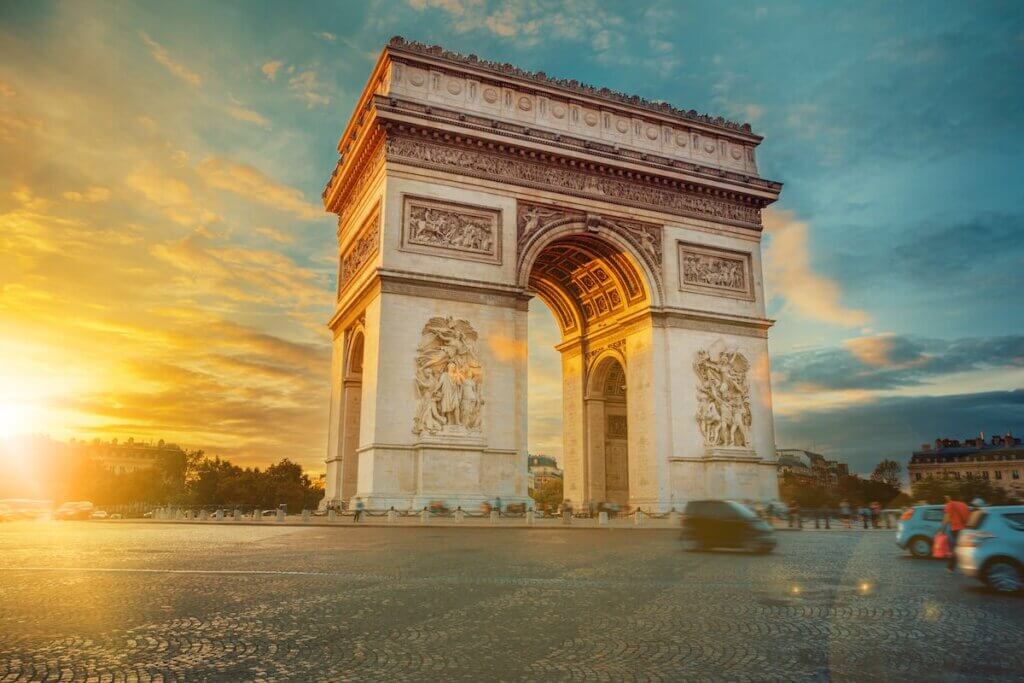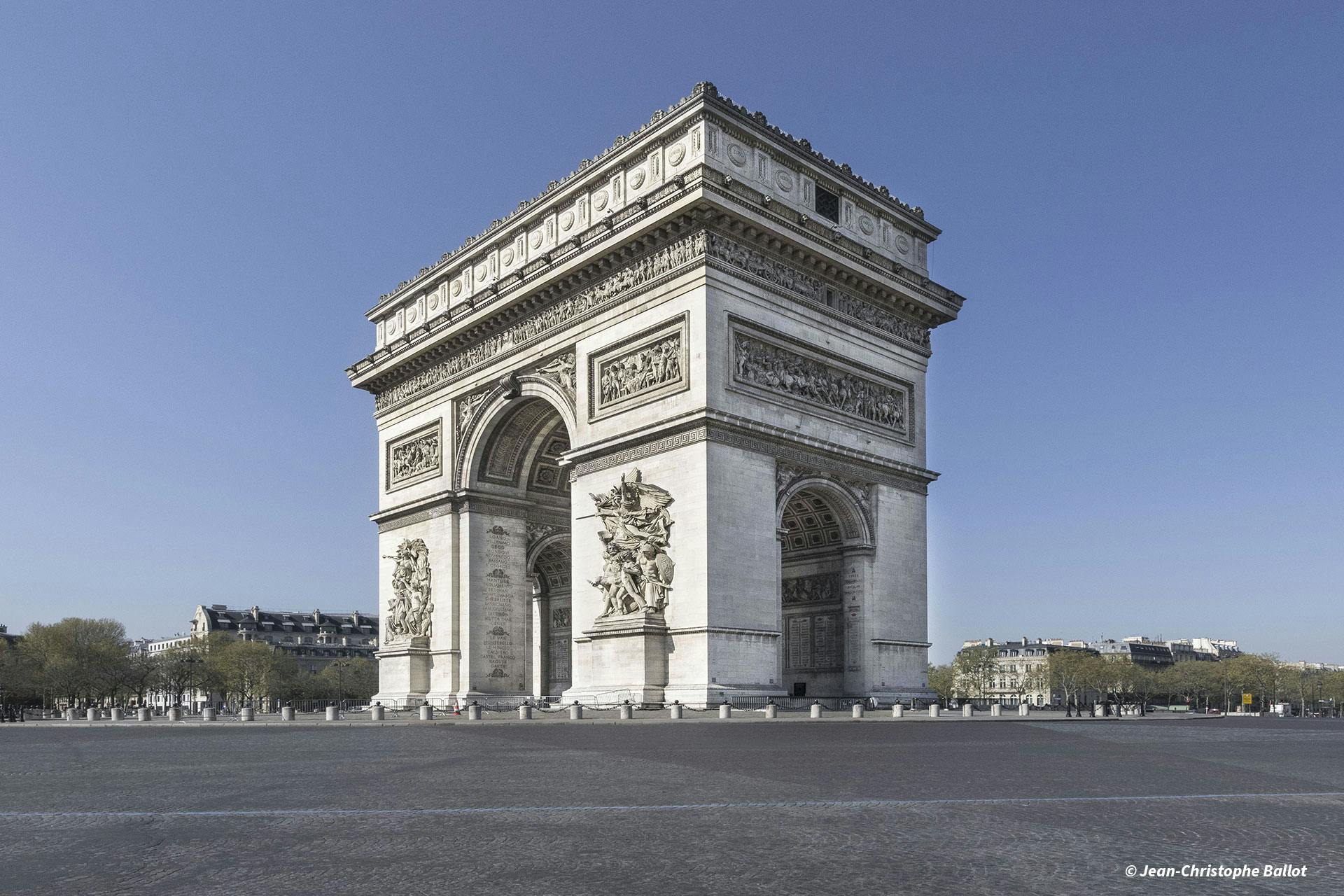
Introduction
Overview of the Arc de Triomphe
The Arc de Triomphe stands majestically at the western end of the Champs-Élysées, serving as a monument to France‘s military victories. This iconic structure, completed in 1836, attracts millions of visitors each year, who come to admire its grand design and historical context.
Historical Significance of the Monument
This monument is not just a stunning architectural achievement; it also holds deep historical significance, as it commemorates:
- The soldiers who fought for France during various wars
- The nation’s resilience and spirit in times of adversity
- Napoleon Bonaparte ‘s vision of a unified France
Each year, the Arc de Triomphe remains a focal point for national pride and remembrance, making it a testament to France’s enduring legacy.

Construction and Design
Architectural Features of the Arc de Triomphe
The Arc de Triomphe is a remarkable example of neoclassical architecture, featuring:
- A height of 50 meters, towering over the Place Charles de Gaulle
- Four sculpted pillars adorned with reliefs depicting historic battles
- An intricate frieze showcasing the names of 558 French generals
Its grandeur is truly awe-inspiring and reflects the artistry of its era.
Construction Challenges and Innovations
The journey to build this monumental structure was not without its hurdles. The major challenges included:
- Adverse weather impacting construction schedules
- Sourcing high-quality materials like limestone and marble
- Implementing innovative techniques to ensure structural integrity
Despite these obstacles, the successful completion in 1836 showcased the ingenuity and determination of French architects, leaving a legacy that continues to inspire awe today.

Symbolism and Commemoration
Symbolic Representations in the Design
The Arc de Triomphe is rich in symbolism, each detail carefully crafted to convey powerful messages. This includes:
- The engraved names of important battles and victories, reminding viewers of France’s military history
- Sculptures representing key historical figures, celebrating their contributions to the nation
- The torch of the Unknown Soldier, symbolizing sacrifice and honor
These elements combined evoke a deep sense of national pride.
Commemorative Events and Ceremonies
Throughout the year, the Arc de Triomphe serves as a central hub for significant commemorative events, such as:
- Bastille Day parades, attracting thousands of spectators
- Annual ceremonies honoring the Unknown Soldier, with the rekindling of the eternal flame
These traditions foster a connection between past sacrifices and present patriotism, illustrating the enduring significance of this magnificent monument in France’s collective memory.

Historical Significance
Role of the Arc de Triomphe in French History
The Arc de Triomphe plays a pivotal role in French history, serving as a national symbol of victory and unity. It represents:
- The bravery of soldiers across different eras
- France’s tumultuous journey through revolutions and wars
- A gathering point for national celebrations and commemorations
This monument encapsulates the spirit of a nation that has faced adversities with resilience.
Connection to Napoleon Bonaparte
Napoleon Bonaparte’s vision significantly influenced the Arc de Triomphe’s construction. He commissioned the monument in 1806 to honor his military achievements. Key highlights include:
- The initial concept of celebrating French victories under his rule
- Napoleon’s intention to inspire future generations with a sense of pride
The Arc de Triomphe remains a lasting testament to his ambition and the enduring legacy of the Napoleonic era.

Visiting the Arc de Triomphe
Visitor Information and Tourist Experience
Visiting the Arc de Triomphe is a must for any traveler in Paris. The experience is enhanced by:
- Opening Hours : Open daily from 10 AM to 11 PM, offering ample time to explore
- Entry Fee : A nominal fee provides access to the observation deck with stunning views of the city
- Facilities : Information centers and souvenir shops ensure a seamless visit
The atmosphere is vibrant, surrounded by the hustle and bustle of the Champs-Élysées.
Tips for Exploring the Monument
To make the most of your visit to the Arc de Triomphe, consider these tips:
- Plan Ahead : Visit early in the morning or later in the evening to beat the crowds
- Take the Stairs : Climbing to the observation deck via the 284 steps offers a rewarding experience
- Capture the Moment : Don’t forget your camera; the views from the top are breathtaking
With these insights, your trip to the Arc de Triomphe promises to be memorable and enriching.

Restoration and Preservation Efforts
Restoration Projects throughout History
The Arc de Triomphe has undergone several restoration projects since its completion, reflecting the commitment to preserving this national treasure. Key restoration efforts include:
- 1907-1914 : Comprehensive cleaning and repair of damaged sculptures and details
- 1935 : Installation of protective measures to combat pollution
- 1986 : Major restoration that included structural reinforcements and cosmetic enhancements
These projects highlight the dedication to maintaining the monument’s grandeur for future generations.
Modern Conservation Practices
Today’s preservation efforts incorporate advanced techniques and sustainable practices to protect the Arc de Triomphe. Some notable approaches are:
- Regular Maintenance : Ongoing inspections to address wear and tear promptly
- Innovative Cleaning Techniques : Use of gentle, environmentally friendly cleaning agents
- Public Engagement : Involving the community in awareness initiatives about the monument’s significance
These modern conservation practices ensure that the Arc de Triomphe remains a shining example of French heritage for visitors to enjoy.

Influence on Art and Culture
Impact on Literature, Art, and Cinema
The Arc de Triomphe has inspired countless works across various artistic mediums. Notable influences include:
- Literature : Writers like Victor Hugo referenced the monument, weaving it into the fabric of French identity
- Art : Artists such as Jean-Pierre Cortot have captured its essence through sculptures and paintings
- Cinema : The monument has featured prominently in films, symbolizing romance and adventure in Paris
These representations illustrate the deep cultural significance of the Arc de Triomphe.
Global Recognition and Influence
Beyond France, the Arc de Triomphe enjoys global recognition as a symbol of triumph and resilience. Its architectural style has influenced monuments worldwide, including:
- Arches in the United States : Such as the Washington Square Arch
- Replications in various cities : Mirroring its grandeur in places like Barcelona and Madrid
This versatility showcases how the Arc transcends borders, inspiring admiration and reverence across cultures.

Conclusion
Summary of the Arc de Triomphe’s Legacy
The Arc de Triomphe stands as a profound symbol of French history, artistry, and resilience. Its majestic architecture, rich symbolism, and cultural impact have established it as a beloved landmark. From honoring military victories to inspiring generations of artists and writers, the monument remains an enduring testament to France’s spirit.
Final Reflections and Insights
Visiting the Arc de Triomphe offers more than just a visual treat; it provides a connection to the past. As you stand beneath its grand archway, consider the stories it embodies:
- The bravery of countless soldiers
- The artistic inspirations it has sparked
- The unity it brings during national events
This iconic monument encapsulates the heart of France, inviting all to reflect on its historical significance and cultural richness.




